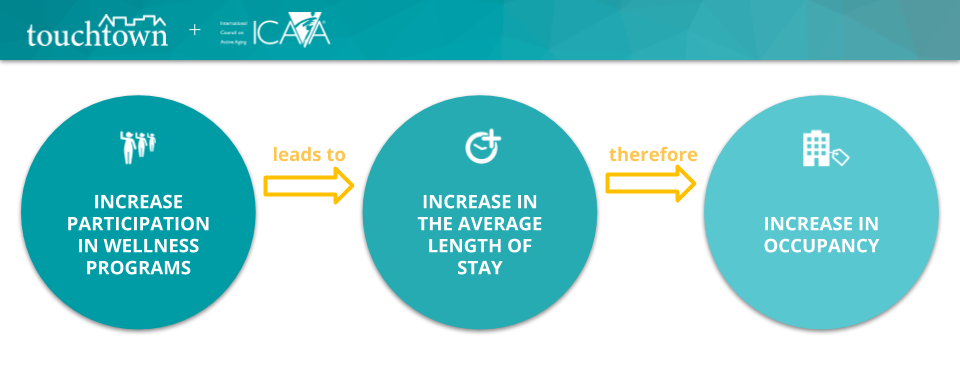Will It Lead To A Wholeness Culture Seniors Love?
By Jack Cumming
Business, for me, is the most effective engine for advancing our human condition. Just think of the consumer value brought to us by indoor plumbing, supermarkets, and smartphones. Business revolves around money. Sound business practices ensure the judicious use of other people’s money to create value.
ROI Analysis
Given my own business outlook, I was motivated to attend a webinar designed by Touchtown and ICAA titled “Using ROI Analysis to Gain Funding for Your Wellness Program.” The idea is a simple one. If those who are serving elders can demonstrate increased revenues from improved occupancy or length of residence, then they can justify financial investment in resident wellness. The webinar host, Ted Teele (CEO of Touchtown), even provided access to a spreadsheet to demonstrate how contributions to wellness improve business metrics.
Future Thinking
One insight that came out in this thought-provoking webinar is that senior housing is moving from a Care Culture to a Wellness Culture. In short, wellness programs are being rethought as a business model permeating the enterprise and elevating its value proposition to a wellness culture. The appeal of wellness, including healthy eating, fitness, socializing, and more, has been growing steadily among aging consumers.
The business premise is that health-oriented people will gravitate toward entities that meet their needs and promote their well-being. Communal living works best to retain vitality in those who are active when they move in. There’s little to be done for those who are socially isolated until it’s too late to do much more than sustain life. But for the younger, vital, new residents social wellness can be a godsend. Moreover, once they find that wellness is central to their experience, they will stay longer, pay more, and spread the word to others like them.
Business Value
As a business person on the webinar, I found the insistence on financial metrics compelling. In business, expenses should be an investment in revenue, and if the connection can’t be made between expense investment and revenue return, the expense should (almost always) be abandoned.
The focus on value distinguishes business enterprises from pure charities, government programs, or hobby efforts. Profit is necessary, though it can become greed, or if ignored, exploitation. The purpose of business is to deliver value to customers and to do so with financial responsibility.
The Wholeness Culture
As I thought about the Wellness Culture concept, my mind moved beyond it to a Wholeness Culture, which may become the common mindset we gravitate toward between now and 2050 (not that far away, after all). People now entering our employ will be no more than middle-aged in 2050. Observing what drives them can inform us about that near-distant world.
Colin Milner of the International Council on Active Aging (ICAA) was on the webinar. The ICAA promotes seven dimensions for aging: Emotional, Vocational, Physical, Spiritual, Intellectual, Social, and Environmental. As I listened, I thought that, if we can reduce the tendency to marginalize the elderly, if we help ensure that each individual has purpose and passion, then we can integrate those seven dimensions into Wholeness. Additionally, Wholeness Culture is not something confined just to the elderly; all of us can benefit from a happy individualized balance in our lives.
Personal Take
Wholeness, too, may bring more age-integrated communities that blur bright lines among staff, volunteers, and residents, just as the divide between work and leisure is blurring for a life-work balance to become more consistent with human fulfillment. The idea of wholeness resonated with me.
Many young people are less materialistic than their elders. We see that in the romance of micro-housing and in the expansion of ride-sharing services as an alternative to car ownership. We’ve come a long way from the materialistic 1928 Herbert Hoover campaign slogan of “a chicken in every pot and a car in every garage.”
It’s still too early to know how prevalent the Wholeness Culture will become and how central it will be for senior housing. It’s something, though, that can be tested now alongside existing offerings – with metrics to track the business value that results. The business maxim is that “you can’t manage what you don’t measure” and that applies to every element in the senior housing customer value proposition.
If the trend evolves, human wholeness for aging residents may become central. Those who prepare now will be ready for the coming era. History shows that those who don’t adapt, wither away and disappear. That was one of the takeaways from the webinar. And panelists suggested that those who adapt to the tides of cultural change will thrive.
Tell Me More
The full webinar is available on demand (click here to access). You also can download an Excel spreadsheet, which permits providers to input their own industry benchmark metrics to track their status and see what the value is of programs and cultural change that they’re implementing or evaluating.








